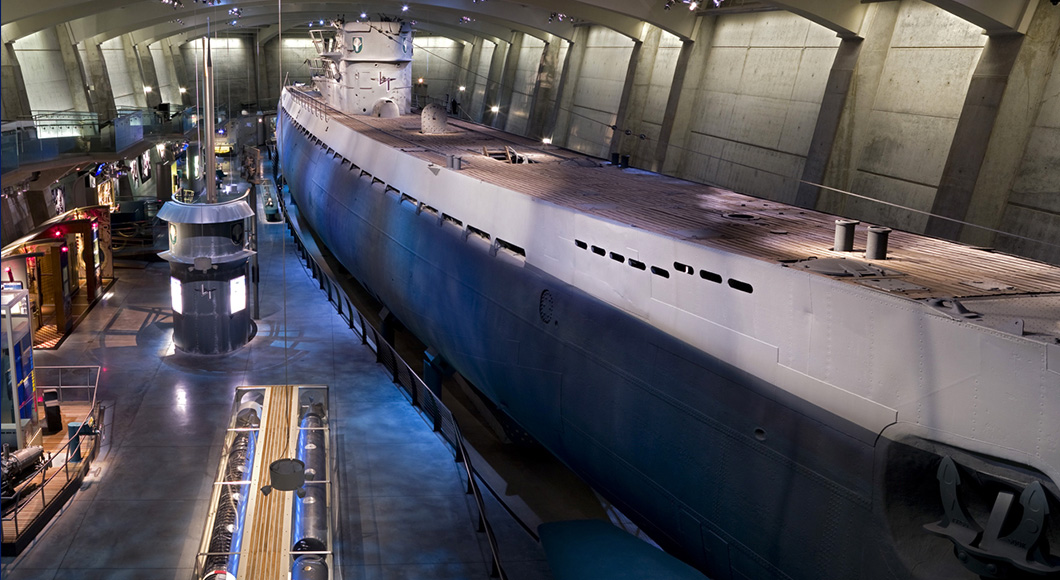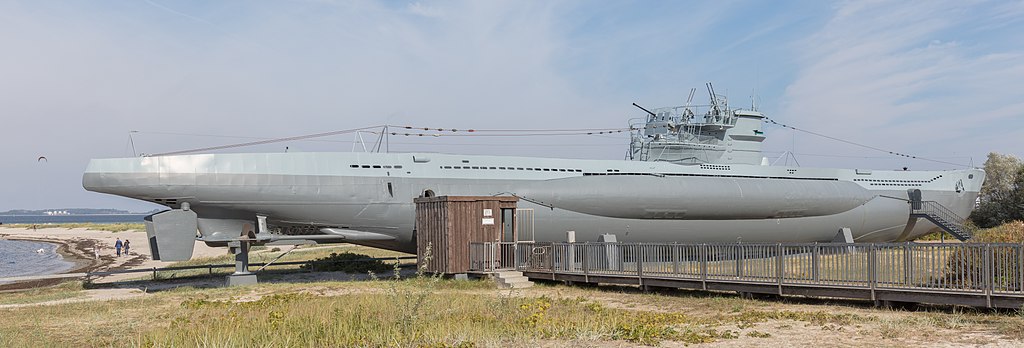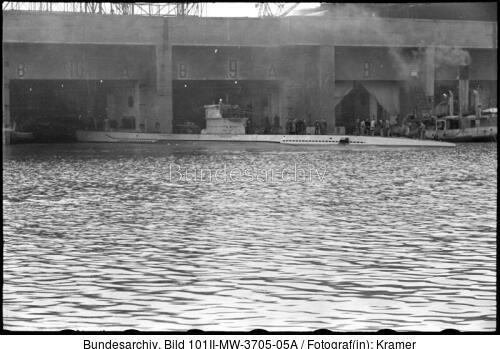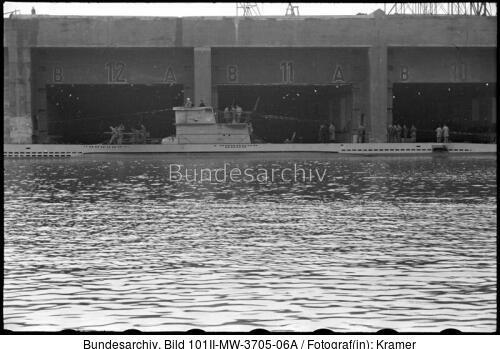We can say with certainty that the German u-boats sailed bow first into the pens at Brest under their own power. There is photographic evidence to suggest that the u-boats backed out of the pens under their own power. In contrast, all u-boats would have needed a tug boat to enter and exit the pens at St. Nazaire.
We arrive at this conclusion by carefully examining the photographic evidence, the blue prints and schematics and by considering the layout of the harbors.
Bollards and bitts
A "bollard" is a sturdy, short, vertical post. The term originally referred to a post on a ship or quay used mainly for mooring boats. Pairs of bollards are known as "bitts". Note that the difference between "bitts" and "bits". This picture from the Chicago Museum of Science and Industry shows the bow of the U-505, a type IX-C submarine. We can clearly see three bitts: one towards the bow and one on either side about half way towards the conning tower. They look like small chimneys.

Logic dictates that the arrangement is mirrored on the other side of the conning tower, but I cannot find a photograph that confirms this. Ironically, the only blue print of a type IX-C submarine that I have available, Tafel VIII from Rössler's book listed below, omits the bitts as the focus is on the onboard storage facilities. Tafel I (type VII-B, 1940) and Tafel IV (type VII-C, 1944) show 6 bitts in the positions that I have indicated. I would be remiss if I did not note that the restored U-995 at the U-boot Ehrenmal at Laboe does not feature any bitts at all, see this photograph by Diego Delso:
 The only features on the deck that could be mistaken for bitts is the stern navigation light and what I believe to be the capstan towards the bow. I can only speculate as to why the bitts were removed.
The only features on the deck that could be mistaken for bitts is the stern navigation light and what I believe to be the capstan towards the bow. I can only speculate as to why the bitts were removed.
We conclude that the German medium and long range U-boats that operated from the bases in France were physically equipped to be pulled from either end and from each side.
Historical photographic evidence
Here we consider the photographs in the online database maintained by the German Federal Archives. The address is https://www.bild.bundesarchiv.de. The next three photographs shows U-552 being pulled from the pen at St. Naizaire.
In the first picture only the tug boat is visible.

In the second picture the submarine has been pulled from the pen and the crew are working to detach the ropes/cables

In the third and final picture, the tug boat is no longer visible.

I cannot be certain that this is the U-552, but the pictures are dated March 1942 consistent with U-552 leaving for its 8th patrol (7 March – 27 April 1942). Moreover, the white blur on the conning tower is compatible with the roaring bull emblem of the 7th flotilla stationed at St. Nazaire which included the U-552. I believe that it would have been necessary to attach ropes/cables and pull the submarine from the bow as space was/is very tight immediately outside the pens at St. Nazaire, see Google Maps at this link.
After these preparations we now turn our attention to the pens at Brest. The next three pictures show a submarine entering the pens under it own power. In the first picture, the boat is approaching the pen. We note the tug boat that has removed part of the barrier floating in front of the pen and the small wave that shows that the submarine is moving under its own power. I believe that the barrier is there to protect the pen from torpedo attack.

In the second picture the boat is passing through the opening in the barrier.

In the third picture the boat is about to enter the pen.

These three pictures are all dated 14 May 1942 and the boat is identified as U-84. This is slightly inconsistent with Wikipedia entry that has U-84 returning from its 4th patrol on 16 May 1942. However, we note that the structure of pen is compatible with OP's diagram of the pens at Brest and the coastline is compatible with Brest, see the Google Maps link below.
I have been unable to find a picture in the German Federal Archives of a submarine actually leaving the pens at Brest. It is clear that it would have been possible to attach a cable and pull the boats out of the pen. If we note the position of the barrier in front of the pen, it appears that there is only marginally more space to maneuver compared with St. Nazaire. However, the barrier can clearly be moved and Google Maps shows that apart from the barrier there would have been amble space in front of the pen. We conclude that it is very likely that the submarines were able to back out of the pen under their own power. This conclusion is supported by the final picture that shows amble space between two submarines in the wet pens in Brest.

Credits for all photographs
All pictures from the German federal archives are clearly marked as such and their unique identification numbers are included. The picture of U-505 is from the webpage of the Chicago Museum of Industry and Science. The picture of U-995 by Diego Delso is published under a CC-BY-4.0 license, see this Wikipedia link.
Searching the German Federal Archives for photographs
Here is an example which shows a search for the string "uboot brest" in the online database at the German Federal Archives. As far as I can determine, the search scans all the meta data of each photograph for a substring matching your query. A search for the single word "brest" yields pictures from Brest-Litovsk. Note that "uboot" and "u-boot" are two distinct strings, so you need to vary your search. Copies of pictures can be purchased by registered users.
Cited books
David Westwood: "Anatomy of the Ship: The Type VII U-Boat", Cambridge
University Press, 1986, ISBN 0 85177 314 1
Eberhard Rössler: "Geschichte des deutchen Ubootbaus", 2.,
überarbeitete und erweiterte Auflage, Bernard & Graefe Verlag, Koblenz
1987. ISBN 3-7637-5801-1 (Band 1), ISBN 3-7637-5802-8 (Band 2), ISBN 3-7637-5800-3 (Gesamtwerk)








